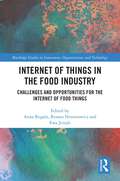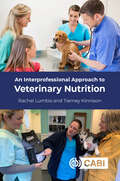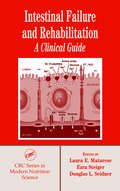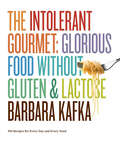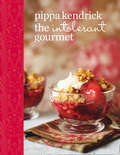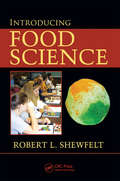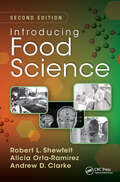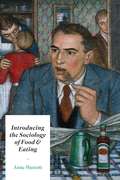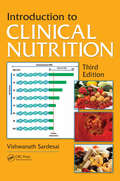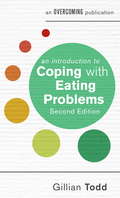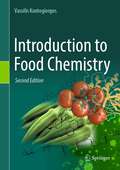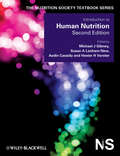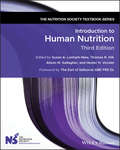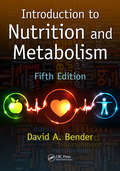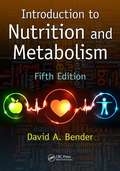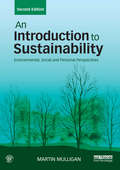- Table View
- List View
Internet of Things in the Food Industry: Challenges and Opportunities for the Internet of Food Things (Routledge Studies in Innovation, Organizations and Technology)
The food industry is experiencing a digital transformation across the entire supply chain, from farm to fork. This book offers comprehensive insights into the challenges and opportunities faced, specifically examining the application of the Internet of Things. The authors analyse the benefits and the related threats from the perspective of the participants of the entire supply chain, including consumers. Taking the reader on a journey, this book begins with an analysis of technology use in farming, production, logistics and retailing before delving into the use of digitalization in educating consumers on sustainable consumption practices. The multifaceted analysis of the Internet of Food potential combines science and practice, enriching theoretical analysis with case studies. This book will be of interest to those researching and studying supply chain management, logistics, innovation and technology management and consumption, with a particular interest in the food industry.
Internet of Things (IoT) Enabled Automation in Agriculture
by Rajesh Singh Anita Gehlot Bhupendra Singh Sushabhan ChoudhuryThis book provides basic knowledge of the programming and interfacing of devices with IoT modem and programming. The aim is to explain the basic steps to understand the IoT and its application in agriculture field. It will serve be a reference book for postgraduate and undergraduate Engineering students. Students from Electronics, Electrical, Mechatronics, Robotics, Mechanical, Computer science can use the book for their projects and research. This book is based entirely on the practical experience of the authors while undergoing projects with the students and industries. Print and electronic editions not for sale in South Asia (India, Sri Lanka, Nepal, Bangladesh, Pakistan, Afghanistan and Bhutan).
Internet of Things (IoT) Enabled Automation in Agriculture
by Rajesh Singh Anita Gehlot Bhupendra Singh Sushabhan ChoudhuryThis book provides basic knowledge of the programming and interfacing of devices with IoT modem and programming. The aim is to explain the basic steps to understand the IoT and its application in agriculture field. It will serve be a reference book for postgraduate and undergraduate Engineering students. Students from Electronics, Electrical, Mechatronics, Robotics, Mechanical, Computer science can use the book for their projects and research. This book is based entirely on the practical experience of the authors while undergoing projects with the students and industries. Print and electronic editions not for sale in South Asia (India, Sri Lanka, Nepal, Bangladesh, Pakistan, Afghanistan and Bhutan).
An Interprofessional Approach to Veterinary Nutrition
by Rachel Lumbis Tierney KinnisonIn veterinary practice, the interface between veterinarians, veterinary nurses or technicians, and paraprofessional team members is crucial. It influences patient care, incidence of medical errors, client satisfaction, success of the veterinary practice and revenue generation. Ensuring a coherent approach to the maintenance of animal health and wellbeing is of paramount importance, yet challenges such as interprofessional prejudice, misunderstanding of motivations, and a lack of recognition, respect, empowerment or trust, can prevent best practice. Nutrition is one of the most important considerations in the maintenance of health, and plays a critical role in disease management, patient recovery and hospital outcome; a reflection of its recognition as the fifth vital assessment. Owners are increasingly aware of the role of nutrition in optimising pet health, yet considerable misinformation can make this one of the most difficult aspects of pet ownership. Playing a central role as a source of expert information, veterinary healthcare teams must rise to the challenge of optimising pet nutrition. Effective interprofessional communication and collaboration is considered a key factor in the successful implementation of nutritional assessment, and a positive team environment founded on respect, trust and mutual support helps overcome challenges and provide the best outcome for both pets and their owners. This book provides evidence-based theory in an accessible and practical way to help veterinary healthcare teams implement interprofessional approaches to nutritional care and support.
The Intersection of Food and Public Health: Current Policy Challenges and Solutions (Public Administration for Public Health)
by A. Bryce Hoflund John C. Jones Michelle C. PautzPresently, ideas about food are in flux from a variety of sources. Examples of this evolution include recognizing the importance of food on health by public health and medical professionals; changing consumer desires around the production methods and components of their food; a greater focus on injustices within the national food system; evolving knowledge of how the food system impacts the environment; and, shifting economic and technological realities that underpin where and how food is produced, distributed and sold. These shifting ideas about food exist in contrast to the narrative of the highly functioning, industrialized, global food system that emerged in the second half of the 20th century. This edited volume fills a void by presenting a comprehensive and engaging coverage of the key issues at the intersection of public health, policy, and food. The Intersection of Food and Public Health is comprised of research that examines current problems in food studies and how various stakeholders are attempting to address problems in unique ways. The book will be of interest to undergraduate and graduate students in a variety of disciplines, including public administration, public policy, public health, economics, political science, nutrition, dietetics, and food studies.
The Intersection of Food and Public Health: Current Policy Challenges and Solutions (Public Administration for Public Health)
by A. Bryce Hoflund John C. Jones Michelle C. PautzPresently, ideas about food are in flux from a variety of sources. Examples of this evolution include recognizing the importance of food on health by public health and medical professionals; changing consumer desires around the production methods and components of their food; a greater focus on injustices within the national food system; evolving knowledge of how the food system impacts the environment; and, shifting economic and technological realities that underpin where and how food is produced, distributed and sold. These shifting ideas about food exist in contrast to the narrative of the highly functioning, industrialized, global food system that emerged in the second half of the 20th century. This edited volume fills a void by presenting a comprehensive and engaging coverage of the key issues at the intersection of public health, policy, and food. The Intersection of Food and Public Health is comprised of research that examines current problems in food studies and how various stakeholders are attempting to address problems in unique ways. The book will be of interest to undergraduate and graduate students in a variety of disciplines, including public administration, public policy, public health, economics, political science, nutrition, dietetics, and food studies.
Intestinal Failure and Rehabilitation: A Clinical Guide
by Laura E. Matarese Ezra Steiger Douglas L. SeidnerThe introduction of parenteral nutrition support has given patients with short bowel syndrome the time they need to achieve maximal intestinal rehabilitation and has allowed these patients to survive. The pioneering work of Drs. Byrnes and Wilmore in the 1990s focused on novel techniques to enhance intestinal adaptation and absorption, including mo
The Intolerant Gourmet: Glorious Food without Gluten and Lactose
by Barbara KafkaAt last—a cookbook of pleasure, not compromise, for those with food intolerancesIt’s estimated that nearly 1 in 3 North Americans is lactose-intolerant and that 1 in 133 is gluten-intolerant, although many of these people remain undiagnosed. For those who do find out, the resulting dietary adjustments have traditionally been about restriction, denial, and deprivation. All these compromises drain the pleasure from eating.Now, legendary food maven Barbara Kafka comes to the rescue with a complete soup-to-nuts cookbook full of great food that you can enjoy every day. Barbara’s own intolerances, dormant since childhood, returned five years ago, and—as someone who was already intolerant of bad food, ersatz ingredients, and poor cooking—she rose to the challenge of being gluten- and lactose-intolerant with this collection of 300 recipes. They get you to crispy without resorting to breading or flour coatings, offer silkiness and richness without dairy, and feature luxurious textures in sauces and soups without flour or butter. Thanks to the creativity of Barbara Kafka, you can say good-bye to the blandest of diets and indulge in such delights as Chicken with Chervil Sauce, Roasted Salmon with Dill Sauce, Cannellini and Mushroom Soup, Corn Relish, and Asian Noodle Salad. The Intolerant Gourmet contains an enormous range of dishes that fit into many cherished culinary traditions (Asian, French, American, Italian, etc.). Each delicious recipe will satisfy anyone at the dinner table, whether intolerant or not. The book also features tools such as a guide to gluten-free pastas and a comprehensive section on starches—their assets and detriments, the basic methods for preparing them, and the best ways of serving them. All is presented with insight and irrepressible wit (of her Simple Rib Roast, for instance, Barbara writes ,“My roast is rare, but no Saxon pillage”). The result is an indispensable reference tool, ideal for lovers of good food in search of an all-inclusive approach to cooking.
The Intolerant Gourmet: Delicious Allergy-friendly Home Cooking For Everyone
by Pippa KendrickFood writer and cook Pippa Kendrick revolutionises allergy-friendly food with an inspired collection of delicious recipes for everyone to make, share and enjoy – and just happen to be free from wheat, gluten, yeast, egg, dairy and soya.
Introducing Food Science
by Robert L. ShewfeltAs daily consumers of foods and beverages, everyone has opinions and interests about their diet choices. However, many questions about food are often non-technical and, therefore, defy technical answers. Introducing Food Science addresses a range of food issues facing today's consumer, proceeding from a general and student-friendly discussion to an
Introducing Food Science
by Robert L. Shewfelt Andrew D. Clarke Alicia Orta-RamirezWritten as an introductory food science textbook that excites students and fosters learning, the first edition of Introducing Food Science broke new ground. With an easy-to-read format and innovative sections such as Looking Back, Remember This!, and Looking Ahead, it quickly became popular with students and professors alike. This newly r
Introducing Food Science
by Robert L. Shewfelt Andrew D. Clarke Alicia Orta-RamirezWritten as an introductory food science textbook that excites students and fosters learning, the first edition of Introducing Food Science broke new ground. With an easy-to-read format and innovative sections such as Looking Back, Remember This!, and Looking Ahead, it quickly became popular with students and professors alike. This newly r
Introducing the Sociology of Food and Eating
by Anne MurcottThis textbook equips students with the ability to analyze and think critically about contemporary food topics. A thorough introduction to the sociology of food and eating, the book also acts as a primer to the discipline of sociology more generally. Chapters start with a 'common sense' assumption about food which students frequently encounter in their own lives or in the mass media. Topics include family meals, ethnic cuisines, cooking skills and convenience foods, eating out, food waste, and 'overpackaging'. Anne Murcott shows how systematic academic research approaches can allow students to move beyond 'conventional wisdoms' to examine sociological perspectives on food and eating. Key sociological concerns such as class, gender, age, ethnicity, power and identity are also introduced, accompanied by a wide range of examples from around the globe. By the end, readers will be able to think more critically and to apply sociological approaches to questions about food and society. Introducing the Sociology of Food and Eating is an essential introductory textbook for students in sociology and food studies. It provides readers with a solid basis for success in their studies - and with a new understanding of their own attitudes to food and eating.
Introducing the Sociology of Food and Eating
by Anne MurcottThis textbook equips students with the ability to analyze and think critically about contemporary food topics. A thorough introduction to the sociology of food and eating, the book also acts as a primer to the discipline of sociology more generally. Chapters start with a 'common sense' assumption about food which students frequently encounter in their own lives or in the mass media. Topics include family meals, ethnic cuisines, cooking skills and convenience foods, eating out, food waste, and 'overpackaging'. Anne Murcott shows how systematic academic research approaches can allow students to move beyond 'conventional wisdoms' to examine sociological perspectives on food and eating. Key sociological concerns such as class, gender, age, ethnicity, power and identity are also introduced, accompanied by a wide range of examples from around the globe. By the end, readers will be able to think more critically and to apply sociological approaches to questions about food and society. Introducing the Sociology of Food and Eating is an essential introductory textbook for students in sociology and food studies. It provides readers with a solid basis for success in their studies - and with a new understanding of their own attitudes to food and eating.
Introduction to Clinical Nutrition
by Vishwanath SardesaiDietary factors have been implicated in at least four of the ten leading causes of death in the U.S. (heart disease, cancer, diabetes, and stroke). Nevertheless, physicians frequently receive inadequate training in nutrition to properly counsel their patients. Introduction to Clinical Nutrition, Third Edition discusses the physiologic and metabolic
An Introduction to Coping with Eating Problems (An Introduction to Coping series)
by Gillian ToddEating problems, including anorexia nervosa and bulimia nervosa, can have a devastating impact on sufferers as well as their friends and family. This self-help guide is written by a consultant psychotherapist with extensive experience of treating eating disorders and will help you identify an eating disorder and develop a toolkit of strategies to help you take steps towards overcoming the disorder. It also includes a chapter offering useful guidance for family members.This updated second edition will help you:· Understand how eating disorders develop and what keeps them going· Find the motivation to change · Change how you eat· Challenge negative thinkingThe Introduction to Coping series offers valuable guidance for those seeking help for emotional or psychological problems such as depression and anxiety. Each book gives useful background information and suggests techniques to change unhelpful patterns of behaviour and thinking using cognitive behavioural therapy (CBT) techniques. CBT is recommended internationally to treat a wide range of emotional, psychological and physical conditions including eating disorders.
Introduction to Food Chemistry
by Vassilis KontogiorgosThe complexity of food chemistry makes it a challenging subject for students studying in a food science course. Although there are excellent food chemistry books available in the market they have two major flaws: they are either encyclopedic or they are not pitched correctly to undergraduate food science students. The first problem creates difficulties for students to identify what is important and how much they need to know. The second problem arises when the book is written by authors that are not food scientists (e.g., chemists), they are not academics that are engaged with teaching or they are not sufficiently qualified to teach. In this case, it is difficult to find links between the chemistry of foods and its relevance to applications or, quite frequently, future employment prospects of the student. Introduction to Food Chemistry bridges this gap in the relevant literature, as it employs the latest pedagogical theories in textbook writing to present the subject to students with broad range of cognitive skills. This book presents specific learning objectives for each chapter and is self-contained so students will not need to search for essential information outside the textbook. To support learning, the book has:Didactic elements with information being conveyed with 3D-figures, color-coded schemes and graphs, annotations on figures that link it to the text descriptionsBuilt-in pedagogy and learning activities at the end of each chapter that are linked to the learning objectives.Keywords and concepts for online search to instigate curiosity for further studies.Conversational writing style without losing academic rigorTo support lecturers, the book has:Helps focus teaching preparation on key aspects of food chemistry relevant to both industry and modern research.Aids the preparation of exams, assignments and other types of assessment or learning activities.For lecturers in search of a singular source to aid in their introductory food chemistry courses, look no further than Introduction to Food Chemistry.
Introduction to Food Chemistry
by Vassilis KontogiorgosThe complexity of food chemistry makes it a challenging subject for students studying in a food science course. Although there are excellent food chemistry books available in the market they have two major flaws: they are either encyclopedic or they are not pitched correctly to undergraduate food science students. The first problem creates difficulties for students to identify what is important and how much they need to know. The second problem arises when the book is written by authors that are not food scientists (e.g., chemists), they are not academics that are engaged with teaching or they are not sufficiently qualified to teach. In this case, it is difficult to find links between the chemistry of foods and its relevance to applications or, quite frequently, future employment prospects of the student. Introduction to Food Chemistry, 2nd Edition bridges this gap in the relevant literature, as it employs the latest pedagogical theories in textbook writing to present the subject to students with broad range of cognitive skills. This book presents specific learning objectives for each chapter and is self-contained so students will not need to search for essential information outside the textbook. This new edition has been expanded to include chapters on sweeteners, glass transition, amino acids, proteins for major food commodities and food additives. All of the original chapters have been updated and expanded to include new research and technologies. To support learning, the book has:Didactic elements with information being conveyed with 3D-figures, color-coded schemes and graphs, annotations on figures that link it to the text descriptionsBuilt-in pedagogy and learning activities at the end of each chapter that are linked to the learning objectives.Keywords and concepts for online search to instigate curiosity for further studies.Conversational writing style without losing academic rigorTo support lecturers, the book has:Helps focus teaching preparation on key aspects of food chemistry relevant to both industry and modern research.Aids the preparation of exams, assignments and other types of assessment or learning activities.For lecturers in search of a singular source to aid in their introductory food chemistry courses, look no further than this expanded new edition of Introduction to Food Chemistry.
Introduction to Human Nutrition (The Nutrition Society Textbook)
by Michael J. Gibney Susan A. Lanham-New Aedin Cassidy Hester H. VorsterIn this Second Edition of the introductory text in the acclaimed Nutrition Society Textbook Series, Introduction to Human Nutrition has been revised and updated to meet the needs of the contemporary student. Groundbreaking in their scope and approach, the titles in the series: Provide students with the required scientific basics of nutrition in the context of a systems and health approach Enable teachers and students to explore the core principles of nutrition, to apply these throughout their training, and to foster critical thinking at all times. Throughout, key areas of knowledge are identified Are fully peer reviewed, to ensure completeness and clarity of content, as well as to ensure that each book takes a global perspective Introduction to Human Nutrition is an essential purchase for undergraduate and postgraduate students of nutrition/nutrition and dietetics degrees, and also for those students who major in other subjects that have a nutrition component, such as food science, medicine, pharmacy and nursing. Professionals in nutrition, dietetics, food science, medicine, health sciences and many related areas will also find much of great value within this book.
Introduction to Human Nutrition (The Nutrition Society Textbook)
by Michael J Gibney Susan A Lanham-New Aedin Cassidy Hester H VorsterIn this Second Edition of the introductory text in the acclaimed Nutrition Society Textbook Series, Introduction to Human Nutrition has been revised and updated to meet the needs of the contemporary student. Groundbreaking in their scope and approach, the titles in the series: Provide students with the required scientific basics of nutrition in the context of a systems and health approach Enable teachers and students to explore the core principles of nutrition, to apply these throughout their training, and to foster critical thinking at all times. Throughout, key areas of knowledge are identified Are fully peer reviewed, to ensure completeness and clarity of content, as well as to ensure that each book takes a global perspective Introduction to Human Nutrition is an essential purchase for undergraduate and postgraduate students of nutrition/nutrition and dietetics degrees, and also for those students who major in other subjects that have a nutrition component, such as food science, medicine, pharmacy and nursing. Professionals in nutrition, dietetics, food science, medicine, health sciences and many related areas will also find much of great value within this book.
Introduction to Human Nutrition (The Nutrition Society Textbook)
by Hester H. Vorster Susan A. Lanham-New Thomas R. Hill Alison M. GallagherNow in its third edition, the best-selling Introduction to Human Nutrition continues to foster an integrated, broad knowledge of the discipline and presents the fundamental principles of nutrition science in an accessible way. With up-to-date coverage of a range of topics from food composition and dietary reference standards to phytochemicals and contemporary challenges of global food safety, this comprehensive text encourages students to think critically about the many factors and influences of human nutrition and health outcomes. Offers a global, multidisciplinary perspective on food and nutrition Covers nutrition and metabolism of proteins, lipids, carbohydrates and vitamins and minerals Explores new developments in functional foods, supplements and food fortification, and future challenges for nutrition research and practice Explains the digestion, absorption, circulatory transport, and cellular uptake of nutrients Demonstrates the structure and characteristics of nutrients, and the relationship with disease prevention A primary text in nutritional science classes worldwide, Introduction to Human Nutrition is a vital resource for students in areas of nutrition, dietetics, and related subjects that involve principles of nutrition science.
Introduction to Human Nutrition (The Nutrition Society Textbook)
Now in its third edition, the best-selling Introduction to Human Nutrition continues to foster an integrated, broad knowledge of the discipline and presents the fundamental principles of nutrition science in an accessible way. With up-to-date coverage of a range of topics from food composition and dietary reference standards to phytochemicals and contemporary challenges of global food safety, this comprehensive text encourages students to think critically about the many factors and influences of human nutrition and health outcomes. Offers a global, multidisciplinary perspective on food and nutrition Covers nutrition and metabolism of proteins, lipids, carbohydrates and vitamins and minerals Explores new developments in functional foods, supplements and food fortification, and future challenges for nutrition research and practice Explains the digestion, absorption, circulatory transport, and cellular uptake of nutrients Demonstrates the structure and characteristics of nutrients, and the relationship with disease prevention A primary text in nutritional science classes worldwide, Introduction to Human Nutrition is a vital resource for students in areas of nutrition, dietetics, and related subjects that involve principles of nutrition science.
Introduction to Nutrition and Metabolism
by David A. BenderUnderstanding the way in which nutrients are metabolised, and hence the principles of biochemistry, is essential for understanding the scientific basis of what we would call a healthy diet. Extensively revised and updated to reflect current knowledge of nutritional and dietary requirements, Introduction to Nutrition and Metabolism, Fifth Edition pr
Introduction To Nutrition And Metabolism, (5th Edition) (PDF)
by David A. BenderUnderstanding the way in which nutrients are metabolised, and hence the principles of biochemistry, is essential for understanding the scientific basis of what we would call a healthy diet. Extensively revised and updated to reflect current knowledge of nutritional and dietary requirements, Introduction to Nutrition and Metabolism, Fifth Edition presents an accessible text on the basic principles of nutrition and metabolism and the biochemistry needed for comprehending the science of nutrition. This full-color text explores the need for food and the uses to which that food is put in the body, as well as the interactions between health and diet. It describes the metabolic pathways and the biochemical basis of their nutritional and physiological importance. Topics covered include chemical reactions and catalysis by enzymes; the role of ATP; digestion and absorption of carbohydrates, fats, and proteins; issues associated with being overweight; problems of malnutrition; and vitamin and mineral requirements and functions. This new edition contains significantly expanded information on a variety of subjects including appetite control, hormone action, and integration and control of metabolism. The fifth edition also includes a list of key points at the end of each chapter. This text explains the conclusions of the experts who have deliberated on nutritional requirements, diet, and health, as well as the scientific basis for the conclusions they have reached. It also provides a foundation of scientific knowledge for the interpretation and evaluation of future advances in nutrition and health sciences. The accompanying CD-ROM contains new interactive tutorial exercises, PowerPoint presentations for each chapter, self-assessment quizzes, simulations of laboratory experiments, and a nutrient analysis program.
An Introduction to Sustainability: Environmental, Social and Personal Perspectives
by Martin MulliganAn Introduction to Sustainability provides students with a comprehensive overview of the key concepts and ideas which are encompassed within the growing field of sustainability. The fully updated second edition, including new figures and images, teases out the diverse but intersecting domains of sustainability and emphasises strategies for action. Aimed at those studying the subject for the first time, it is unique in giving students from different disciplinary backgrounds a coherent framework and set of core principles for applying broad sustainability principles within their own personal and professional lives. These include: working to improve equality within and across generations; moving from consumerism to quality of life goals; and respecting diversity in both nature and culture. Areas of emerging importance such as the economics of prosperity and wellbeing stand alongside core topics including: · Energy and society · Consumption and consumerism · Risk and resilience · Waste, water and land. Key challenges and applications are explored through international case studies, and each chapter includes a thematic essay drawing on diverse literature to provide an integrated introduction to fundamental issues. Housed on the Routledge Sustainability Hub, the book’s companion website contains a range of features to engage students with the interdisciplinary nature of sustainability. Together these resources provide a wealth of material for learning, teaching and researching the topic of sustainability. This textbook is an essential companion to any sustainability course.
